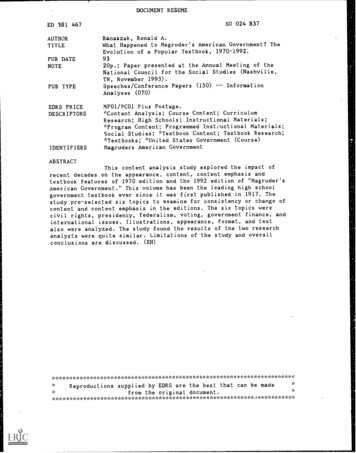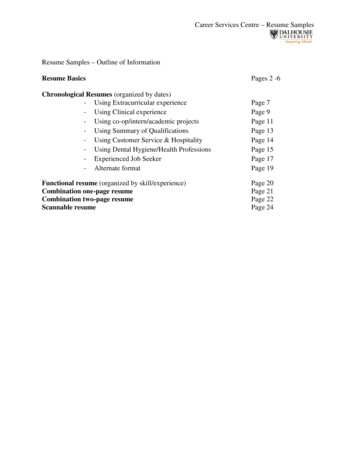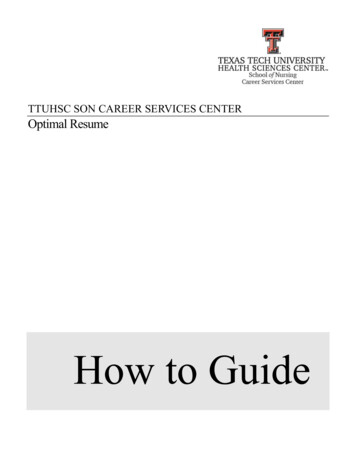
Transcription
DOCUMENT RESUMESO 024 837ED 381 467AUTHORTITLEBanaszak, Ronald A.What Happened to Magruder's American Government? TheEvolution of a Popular Textbook, 1970-1992.PUB DATENOTE93PUB TYPEEDRS PRICEDESCRIPTORSIDENTIFIERS20p.; Paper presented at the Annual Meeting of theNational Council for the Social Studies (Nashville,TN, November 1993).InformationSpeeches/Conference Papers (150)Analyses (070)MF01/PC01 Plus Postage.*Content Analysis; Course Content; CurriculumResearch; High Schools; Instructional Materials;*Program Content; Programmed Instfuctional Materials;Social Studies; *Textbook Content; Textbook Research;*Textbooks; *United States Government (Course)Magruders American GovernmentABSTRACTThis content analysis study explored the impact ofrecent decades on the appearance, content, content emphasis andtextbook features of 1970 edition and the 1992 edition of "Magruder'sAmerican Government." This volume has been the leading high schoolgovernment textbook ever since it was first published in 1917. Thestudy pre-selected six topics to examine for consistency or change ofcontent and content emphasis in the editions. The six topics werecivil rights, presidency, federalism, voting, government finance, andinternational issues. Illustrations, appearance, format, and textalso were analyzed. The study found the results of the two researchanalysts were quite similar. Limitations of the study and overallconclusions are discussed. **************************Reproductions supplied by EDRS are the best that can be made*from the original ******************4***********''
fWhat Happened to Magruder's AmericanGovernment?The Evolution of a Popular Textbook, 1970-1992byRonald A. BanaszakCollege of EducationUniversity of AlabamaU.S. DEPARTMENT OF EDUCATIONOffice d Educational Research and improvementE)UCATIONAL RESOURCES INFORMATIONCENTER (ERIC)Thi* document has been reproduced as*wed from the person or orgcnaallonortginating itO Minor changes have been mode to improvereproduction qualityPants of view or opinions stated in this docu-ment do not necessarily represent officialOERI positron or policy"PERMISSION TO REPRODUCE THISMPRELIMINARY FINDINGSC)cRIAI HAS BEEN GRANTED BYTO THE EDUCATIONAL RESOURCESINFORMATION CENTER (ERIC)"Paper Presented at the NCSS Annual MeetingNashville, TN1993C.)BEST COPY AVAILABLE
What Happened to Magruder's American Government?The Evolution of a Popular Textbook, 1970-1992Ronald A. BanaszakIntroductionThis research project compared the 1970 and 1992 editions of Magruder'sAmerican Government to determine how the text had evolved. During the yearsbetween these two editions enormous changes occurred in the United Statesand in expectations of textbooks. The researcher sought to explore changes inappearance, content, content emphasis and textbook features.Evidence is clear that textbooks have a powerful influence over classroompractice. One study concluded, "In most elementary and secondary schools.textbooks are important bases of curriculum planning, particularly in decisic.about the scope and sequence of course content." (Project SPAN Staff, 1982) Ahistory of American textbooks by the American Textbooks Publishers Instituteconcluded accurately, though self-servingly, "Not in Horace Mann's day . nornow, could there be found a school or school system capable of functioning forso long as a single term without the sustaining imperative aid of textbooks."(1949, 12) John Goodlad's study of schooling revealed that 88 percent of seniorhigh students use textbooks. (Wright, 1980) Another study found that about 60percent of classroom time involved the use of printed materials, mostlytextbooks. (EPIE, 1977) Textbooks account for at least three-quarters ofstudents' exposure to the written word in school. (Keith, 1991) And about half ofall social studies teachers use only a single basal text. (Wiley, 1977) It is safe tostate that a majority of classroom dynamics is shaped by the selected textbook.Thus the content of textbooks is an important topic for research.The textbook industry in the United States is composed of privately owned andoperated companies who engage in a quasi-public function in openly competitivemarkets to generate profits. Textbooks in the United States are not produced bygovernment agencies (though government funding has supported thedevelopment of innovative materials) or quasi-government development groupsas .n many other countries, but by market-driven independent companies. Thetextbock industry has a long history. Coote's The English Schoolmaster, firstissued in London in 1596, is the earliest imported spelling book. The firsttextbook issued in America was a spelling book published by Stephen Gayebetween 1641 and '643. Other textbooks followed, but by far the most influentialand successful was The New England Primer. Copies could be found in almostevery home, usually near the Bible. In the 1740's The Christopher SowerCompany, the first textbook publishing house in America, was established. In23
his early 20's, Noah Webster wrote his first textbook, a spelling book. Otherspellers and reading books became common. By the middle of the nineteenthcentury graded series of textbooks were being published. The most successfulseries in the 1800's was a series of readers written by Dr. William HolmesMcGuffey. By 1920 when the series was still being used, over 122 million copiesof the seven readers had been sold. The New England Primer, Webster'sSpeller, and McGuffey's Readers dominated the first 150 years of textbookpublishing in the United States.(Textbooks, 1949)No textbooks have equaled their success since and none probably ever willagain, but Magruder's American Government has been the leading high schoolgovernment textbook ever since it was first published in 1917. Certainly noother social studies textbook has been so successful. It is currently published ina new edition annually instead of the more normal revision cycle of every four tosix years. Given the changes that have occurred since 1917, the consistentsales of the text are quite remarkable. Yet since current copyright law requiresonly a five percent change, a new edition could be regularly published, but thecontent might actually change little.This study explored the impact of recent decades on the appearance, content,content emphasis and textbook features of Magruder's American Government.The 1960's were a decade of turmoil. From the U2 incident, through the electionand assignation of Kennedy, the Great Society, school integration, the Viet NamConflict to the election of Nixon, the 1960's were unpredictable. In addition, the1960's were a period of experimentation in social studies education. The 1970'sand 1980's were no less remarkable for being unpredictable. One of thepurposes of this study was to determine to what extent these societal events andchanges in social studies may have effected Magruder's American Government.For convenience, the 1970 edition will be referred to in this paper as 1970 andthe 1992 edition as 1992.ProcedureMany comparisons were made between the two editions. The ccmparison wasmade by a social studies graduate student and a social studies professor. Theresearchers independently studied the two texts and reached their conclusions.After completing their analysis, their conclusions were found to be quiteconsistent. In cases of inconsistency, the results were discussed untilconsensus was reached. To determine general editorial changes, the Table ofContents of both books was compared. Chapters were compared la determinechanges in the appearance and format of the text. To determine the percent oftext devoted to illustrations, ten randomly selected portions of the text, each tenpages long were chosen. Researchers were careful to exclude from this34
analysis pages containing end of chapter exercises. The portion of these 100pages devoted to illustrations of any type was counted. The total space used forillustrations was calculated as a percentage of the 100 pages. To determine thenumber of words per page, the words in five randomly selected ten linepassages were counted. They were averaged to determine the average numberof words per ten lines. Then that number was multiplied by the number of lineson a page completely devoted to narrative.To help determine the extent of consistency or change of content and contentemphasis between the two editions, six topics were examined in detail. Thecontent related to these topics was identified using the table of contents andindex in each text. Every identified passage was compared paragraph byparagraph. Detailed notes were kept of the paragraph by paragraphcomparison. Both researchers identified the passages and analyzed themindependently. Then their results were compared. There was littledisagreement. In cases of inconsistency, the researchers reexamined thepassages and discussed them until consensus was reached.Appearance and FeaturesThe two editions are approximately the same dimensions, though 1992 is .5 inchwider and taller. Table One summarizes the physical characteristics of botheditions. The most striking difference is the much more attractive appearance of1992. The cover is in full-color with flags waving. An abstract design and mutedcolors are used on the cover of 1970. The colorful appearance continues inside1992. Virtually every page has at least one second color and all illustrations arein full color. By contrast, 1970 has only one full-color illustration, a map of theUnited States, and most pages have no second color. When a second color isused, it is a dull, yellow-orange. The overall effect makes 1992 appear moreexciting and inviting, compared to the dull appearing 1970.Table One About HereColor in 1992 is not just for appearance. Headings and subheadings are printedin different colors in a consistent pattern allowing students to quickly see thechapter's outline. Chapters are clearly divided into numbered sections thatbegin with advance organizers and end with review questions. Chapters in 1970are also divided into sections, but in the form of an outline rather than ateachable portion of the text. Sections in 1992 are more clearly viewed as aself-contained lesson. The 25 chapters in 1992 are grouped into seven units. In1970, there is no unit arrangement of chapters. Instead the 43 chapters aregrouped into three parts, "Foundation and Principles of American Government,"4
"National Government," and "State and Local Governments." Average chapterlength in 1970 is 17.2 pages compared to 26.8 pages in 1992.The four-color illustrations in 1992 are plentiful. About 28 percent of 1992 isillustrations, including photographs, graphs, charts and tables. Only 17 percentof 1970 is illustrations. Yet because there are more words per page in 1992(732 words per page) compared to 1970 (702 words per page), the amount ofnarrative is more modestly reduced by about nine percent.1992 appears to be more student friendly in a number of ways. In addition to theuse of color and the more obvious outline of the chapters, new features havebeen added. These are summarized in Table Two. Each chapter has advanceorganizers. A "Chapter Preview". introduces the chapter. It also asks :tudents tothink about the content of the chapter before reading it. For example, at thebeginning of the chapter on civil liberties, students are asked to "Describe yourdefinition of justice. Predict what might occur if safeguards for people accusedof crimes did not exist." (516) The preview continues to point out the mainobjective of each section. Each section of each chapter has cueing questionsand a list of key terms. At the end of each section, factual recall questions areasked and one critical thinking question. For example, the question at the end ofthe section dealing with due process of law asks students, "Considering theconstitutional right to privacy, do you think it is proper for a State to use its policepower to promote morals among its citizens?" (520) The end of chapterexercises in both editions are similar. At the end of each chapter in 1992 is a"Chapter-in-Brief' section that reviews the key content in each section of thechapter. End of chapter exercises covers key terms and factual information.Also included are several critical thinking questions and involvement exercises.1970 had a "Summary" at the end of each chapter, terms to define, factualreview questions, questions for discussion and suggested activities. Missingfrom 1992 is the list of suggested readings for each chapter that 1970 had.Instead, 1992 has suggested readings by unit in the Government ResourcesHandbook.Table Two About HereSprinkled throughout 1992 are new special features. 1970 had no specialfeatures. The following types are included in 1992:"Debating Key Issues" Each focuses on an important Supreme Court casesuch as Hazelwood v. Kuhlmeier, Gregg v. Georgia, Feiner v. New York,United States v. Nixon, Tinker v. Des Moines, and others."What You Can Do" Each is an example of student participation ingovernment. Stories deal with an environmental campaign, changing a state5r
law, helping victims of natural disasters, volunteering for community service,and others."Voices on Government" These 25 quotations from prominent Americansoffer opinions, views and comments on the American political system.Included are Antonia Hernandez, James Madison, Jack Kemp, Martin LutherKing, Jr., George Gallup, Ralph Nader, Jimmy Carter, George Bush, ColinPowell, Natalie Koulik and many others"Skill Lessons-Critical Thinking" These exercises focus on expressingproblems clearly, drawing conclusions, identifying central issues, determiningrelevance, distinguishing fact from opinion, recognizing cause and effect,making comparisons, and similar thinking skills."Skill Lessons-Citizenship" These exercises focus on citizen political actionssuch as how to work in groups, how to file a consumer complaint, how to starta small business, how to write to your legislators and how to file a claim insmall claims court.The appendix of 1992 contains many more items than the one in 1970. The1970 appendix is limited to historical documents of the Declaration ofIndependence, The Articles of Confederation, and The Constitution of the UnitedStates of America. 1992 has the same documents, but also includes aGovernment Resources Handbook, U. S. Data Bank, World Data Bank, Outlineof the Constitution, eight other historical documents (ranging from the Code ofHammurabi, through several Federalist Papers to the EmancipationProclamation), Supreme Court glossary of important cases, and glossary. TheGovernment Resources Handbook is especially important and will becommented on more extensively in the next section.General EditorialEven a cursory examination of 1970 and 1992 will establish that they aredifferent editions of the same text. That is not to say that significant changeshave not been made (they have!), but the basic content flow is more alike thandifferent. Both begin with general chapters on the principles of government, theorigins of American government, the Constitution and federalism. Chaptersfollow that deal with political parties, voting, the electoral process, public opinionand pressure groups. Next the legislative branch, executive branch and judicialbranch are treated in that order. Both end with state and local government.6
Of course, 1992 has been updated to cover contemporary politicaldevelopments. Both books even have a final section titled "Stop the Presses" inwhich very recent events are covered. For 1970, this section contains items onapproval of a lottery system for selective service, tax reform, start of the SALTtalks, census bureau estimates, return of Okinawa to Japan, creation ofDepartment of Housing and Urban Development, and others. This feature in1992 includes the latest information on the dissolution of the Soviet Union,several recent Supreme Court cases, Federal Election Commission funding forcampaigns, a cabinet appointment and census bureau estimates. In botheditions page references are included for related content in the body of thetextbook.Most of the same content is present in both editions, but it has been reorganizedsome. The number of chapters has been reduced from 43 in 1970 to 25 in 1992.This was accomplished by rearranging and combining content. In many cases,1970 chapters were incorporated with the old chapter titles appearing as subheadings in 1992 chapters. In some cases, 1970 content was omitted. In thefollowing discussion of six topics, specifics will be provided.There is a major shift in content emphasis between 1970 and 1992 from a focuson structure and function of government to one on how government actuallyworks. The detailed description of executive departments and regulatorycommissions contained in 1972 was shortened considerably. 1970 devotesthirteen chapters or 190 pages, 25.7 percent of the chapter narrative toexecutive departments and regulatory commissions. 1992 covers them in onefull chapter and in the Government Resources Handbook, a total of 38 pages(5.6 percent of the chapter narrative). Of course, 1992 does not provide nearlyas much detail, but still clearly describes each in sufficient detail so students canunderstand their function.State and local government also receives much less attention in 1992. 1970 hasten chapters (144 pages or 19.5 percent of the chapter narrative) while 1992 hasonly two chapters (56 pages or 8.4 percent of the chapter narrative). In thisreduction, coverage of state constitutions is reduced from a 12 page chapter toone page. State legislatures, governorship, state courts, and financing stategovernment are each reduced from a chapter to a section within a chapter.There is no coverage of rural local government in 1992, but an entire chapter isdevoted to this topic in 1970. 1992, however, sensibly discusses state servicesin one section; in 1970, the discussion is spread over several chapters. Cityplanning is left out of 1992, as is much of the discussion of state and localagencies.These reductions shift 35.8 percent of chapter narrative away from federalagencies and state and local government and permit extended coverage of othertopics. Two new chapters have been added dealing with comparative political7
and economic systems (53 pages). These topics are briefly treated (16 pages )in 1970 in chapter one. These new chapters cover the political systems of GreatBritain, Japan, Mexico and the former Soviet Union. The economic chapterdiscusses capitalism, socialism and communism. Extended coverage isprovided of other topics such as civil rights, voting and international issues.These topics are further detailed in the next section of this report.Anther significant change is the tone of the narrative. 1970 is written in typicalstilted textbook prose using scholarly terms and the specialized language ofpolitical science. 1992 narrative is written in a more direct, less "haughty" style.A concerted effort was made to substitute words that would be familiar tostudents. Thus "compensation" (1970) becomes "pay and benefits" (1992),"suffrage" (1970) becomes "voting" (1992), and "the national judiciary" (1970)becomes "the federal court system" (1992). The change is so dramatic that thetwo editions read as if they were written by two different authors. As a result1992 is much more readable. Listed below are parallel passages from the twoeditions to document the change."Jurisdiction may be defined as the right of a court to hear and determine(to try and decide) a case. Under Article Ill the federal courts have jurisdictionover a case either because of (1) the subject matter involved in the case or (2)the parties involved in the case." (1970, 570)'The constitutional courts hear most of the cases tried in the federalcourts. That is, those courts have jurisdiction over most federal cases.'The word jurisdiction is defined as the authority of a court to hear anddecide a case. The term means, literally, the power 'to say the law.''The Constitution gives the federal courts jurisdiction over certain cases.Article III, Section 2 provides that the federal courts may hear a case eitherbecause of (1) the subject matter or (2) the parties involved in the case." (1992,462)"Obviously, the democratic concept of equality does not claim that all menare born with the same mental or physical abilities. Nor does democracy arguethat ail men are entitled to anshare of worldly goods. It does insist,however, that all men are entitled to : (1) equality of opportunity and (2) equalitybefore the law. That is, rile democratic concept of equality holds that no manshould be held back for any such artificial or arbitrary reasons as those basedon race, color, religion, or economic or social status; that each man should befree to develop himself as fully as he can (or he cares to); and that each manshould be treated as the equal of all others under the law." (1970, 12)"Certainly, democracy does not insist on an equality of condition for allpersons. Thus, it does not claim that all are born with the same mental or8
physical abilities. Nor does it argue that all persons have a right to an equalshare of worldly goods."Rather, the democratic concept of equality insists that all are entitled to(1) equality of opportunity and (2) equality before the law. that is, the democraticconcept of equality holds that no person should be held back for any sucharbitrary reasons as those based on race, color, religion, or sex. The conceptholds that each person must be free to develop himself or herself as fully as heor she can (or cares to) and that each person should be treated as the equal ofall other persons by the law." (1992, 16)"Legally, only a member may introduce a bill in either house of any Statelegislature. So, in a legal sense, it may be said that legislators themselves arethe source for the thousands of measures introduced each year. But, in abroader view, legislators are the actual source for only a relative handful of bills."A large number of bills come from public sources; that is, they originatewith various officers and agencies of the State and a State's many units of localgovernment. The governor's office is generally the prime source for legislation.Every governor has a legislative program of one kind or another, and frequentlythe governor's desires are both ambitious and extensive. His proposals areusually expressed in campaign speeches, inaugural addresses, messages to thelegislature, and the budget he submits to each session. His desires areexpressed in less formal terms, too, as he exerts his political influence on thelegislative process." (1970, 627 & 629)"Legally, only a member may introduce a bill in either house in any of theState legislatures. So, in the strictest sense, legislators themselves are thesource of all measures introduced. In broader terms, however, the lawmakersare the real source, the authors, of only a relative handful of bills."A large number of bills come from public sources, from officers andagencies of State and local government. Every governor has a legislativeprogram of some sortand often an extensive and ambitious one." (1992, 636)Magruder's has traditionaIly used many explanatory footnotes to annotate thenarrative. Both 1970 and 1992 use explanatory footnotes extensively. Whilecharacteristic of Magruder's, the use of these footnotes is unusual in a highschool textbook. The footnotes give Magruder's a scholarly tone and allow thenarrative to flow more freely without incorporating the details contained in thefootnotes in the narrative.Magruder's also has traditionally used Supreme C' urt cases extensively to showthe latest legal interpretation. That tradition still remains intact in 1992. Cases
are used most liberally when dealing with civil rights, but are present where everpertinent.Content AnalysisTo help determine the extent of consistency or change of content and contentemphasis between the two editions, the researchers independently did adetailed comparison of the narrative covering six topics. The six topics werechosen for their potential to reflect the impact of social changes in the UnitedStates during the 1970's and 1980's upon the textbook. The six topics were civilrights, presidency, federalism, voting, federal court system, government financeand international issues.The line-by-line comparison showed that each topic had been updated forcurrent developments. Since Magruder's American Government is updatedannually, rather than the more standard revision rate of every four to six years,the two editions studied were 21 revisions apart. Therefore, there was potentialfor extensive revisions.Though two topics showed little change between 1970 and 1992 (presidencyand federalism), the other five topics showed more extensive revision. Civilrights was revised the most.Presidency.The presidency is covered in chapters 16 and 17 in 1970. Chapter 16 is adescription of the office of the president. It also discusses the office of the vicepresident. Election procedures, conztitutional provisions, electoral collegesystem, and the impact of the rise of political parties are also included. Chapter17 is titled 'The Presidency in Action" and includes such topics as the cabinet,presidential powers and reorganization of the executive branch. These subheadings cover the structure of the executive branch of government and thepower given to the president and other members of the executive branch.Practically the same material is covered in 1992. Both chapter titles are thesame and almost all subheadings. The same information is presented in both,though there has been some reorganization of the content. For example,treatment of the cabinet is moved from the beginning of the chapter to the end in1992. And, of course, 1992 has been updated for recent events.Federalism.Federalism is covered in chapter 4 of both editions. 1970 devotes 18 pages and1992 23 pages to this topic. The additional pages do not reflect more in-depth10i
coverage. Instead, the greata use of illustrations and features explains thedifference. There is no shift in emphasis or change in scope of the materialbetween the two editions. Of course, 1992 is updated for new events. ThusReagan's shift towards block grants for states in the early 1980's gets a briefmention in 1992.Civil Rights.The topic of civil rights shows the greatest difference between 1970 and 1992 of.any other topic analyzed in this research. One obvious difference is theexpansion from one chapter in 1970 (23 pages) to three chapters in 1992 (88pages). The single chapter in 1970 is titled just "Civil Rights;" the threechapters in 1992 are titled "Civil Liberties: First Amendment Freedoms," "CivilLiberties s: Protecting Individual Freedoms," "Civil Rights: Equal Justice UnderLaw." Combined with a chapter describing the federal court system, these threechapters in 1992 comprise the unit title 'The Judicial Branch." Coverage of civilrights is moved later in 1992. In 1970, the discussion of civil rights is in chapter6; in 1992, the discussion is in chapters 19, 20, and 21. In both editionsnumerous court cases are discussed, but the revisions and additions made to1992 make those chapters read like a law-related text.All of the content of 1970 is present in 1992. It has been rearranged to fit intothe three general topics of the 1992 chapters. 1992 introduces the term civilliberties which does not appear in 1970. For each of the following topics, thelisted information has been added in 1992:Chapter 19Freedom of Religionreleased timeprayers and the Biblestudent religious groupseducationseasonal displayschaplain in Congress and the state legislaturestax exemptionsstate aid to parochial schoolsthe Lemon testfree exercise of religionFreedom of Speech and Pressobscenityprior restraintconfidentialitysymbolic speechcommercial speech1112
Freedom of Assembly and Petitiontime-place-manner regulationsdemonstrations on public propertyright of assembly and private propertyfreedom of associationChapter 20Due Process of Lawright of privacyabortionFreedom and Security of the Personautomobilesthe exclusionary rulewiretappingRights of the Accused: Punishmentcapital punishment1992's chapter 21 is without a counter part in 1970. It is a completely newchapter as 1970 had only two pages devoted to equality. Chapter 21 has onesection devoted to diversity in American society, the application of the equalprotection clause of the 14th Amendment and federal civil rights legislation forthe last thirty years. The final section deals with citizenship, naturalization,aliens and immigration policy.Civil rights is treated in much more detail in 1992 both through the inclusion ofnew topics and through a more detailed presentation of content present in 1972.Further, there is a focus on contemporary policy debates such as capitalpunishment, abortion and sex discrimination.Voting.Voting is treated in a single chapter in both editions. The content of thesechapters is almost identical for the first three sections. These cover thehistorical development of the right to vote in the United States, voterqualifications, and civil rights related to voting.Section four in both editions deals with nonvoting. Though both sections havesimilar titles and subheading, there is little similarity in the treatment of thecontent. 1970 deals with the number of nonvoters and then focuses on reasons1213
for nonvoting. 1992 covers the same topics, but the narrative is completelydifferent.Nonvoting in state and local elections, nonvoting for lower offices and structuralcauses of nonvoting (traveling, newly moved, not satisfying voter registrationrequirements) are included in both. The tone of the discussion is quite different.1970 preaches:"Even with all of the reasons we've just listed, the chiefcause for non-voting--the reason why over 20,0
What Happened to Magruder's American Government? The Evolution of a Popular Textbook, 1970-1992. Ronald A. Banaszak. Introduction. This research project compared the 1970 and 1992 editions of Magruder's American Government to determine how the text had evolved. During the years between these two editions enormous changes occurred in the United .











